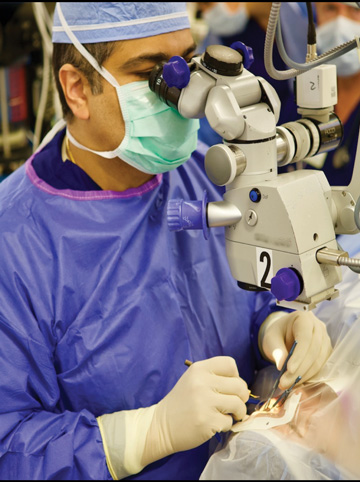In some respects, LASIK can be used as the measuring stick for optimal outcomes. With LASIK, surgeons can consistently achieve +/- .5 diopters of the intended refraction about 90% of the time.
"That’s a pretty good goal for cataract surgery as well,” says Dr. Devgan.
LASIK is very predictable because it eliminates or reduces the variable impact of the patient’s healing, which accounts for about 10% of the outcome. The healing process has a significant impact on cataract surgery outcomes, however, because
it affects the effective lens position (ELP).
The eye’s natural lens that’s removed during cataract surgery is about 4mm thick — about the width of an M&M — and the thickness of the IOL that’s implanted in the eye is less than a millimeter, explains Dr. Devgan.
The eye’s posterior capsule holds the implant in place like shrink wrap, and during the first couple weeks of healing the lens shifts slightly from the position in which it was implanted. Where it comes to rest introduces the variability
in lens calculations and analysis with most surgeons achieving +/- .5 diopter of the target refraction about 80% of the time. “That’s not bad,” says Dr. Devgan, “but there are ways to achieve better outcomes.”
Here are a few of the technologies surgeons are using to meet the post-op vision goals of increasingly demanding patients.
• Lens implants. Dr. Lehmann believes premium IOLs are improving incrementally. “There’s only a certain amount of light that can be split in the eye,” he says. “Splitting light for distance vision manifests
as halos or glare at night or poor contrast sensitivity in dim light. The latest multifocal lenses are better at balancing that tradeoff and lessening the side effects patients experience.”
RxSight’s Light Adjustable Lens (LAL) lets surgeons make small adjustments to the power of the implanted lens through a series of UV light treatments performed over several weeks after surgery. Surgeons can dial in post-op refraction to
within a quarter diopter of the pre-op goal, essentially letting them customize the vision of patients with astigmatism after surgery.
Because surgeons can routinely hit the refractive target in 95% of cases, Dr. Devgan questions the value of scheduling several post-op visits to lock in the optimal outcome unless the patient had previous eye surgery that makes it nearly impossible
to capture accurate pre-op calculations needed for positive refractive results.
Dr. Lehmann reviewed the cases of patients who underwent radical keratectomy (RK), a dated procedure that involved making small incisions in the cornea to help flatten it. The procedure often left patients with large eye prescriptions to fix their
post-op vision and oddly shaped corneas. “It’s notoriously difficult to achieve a good refractive result in these patients,” explains Dr. Lehmann. “With conventional lens implants, we hit the target result about 50%
of the time. The LAL lets us hit the target 90% of the time at three months and 75% of the time at one year post-op, so it’s an improvement of 25% or more.”
Dr. Devgan often implants Alcon’s IQ Vivity in patients. The lens, which was launched in January 2021 and is available in spherical and toric designs, stretches and shifts light instead of splitting it to provide excellent distance vision
afforded by a standard toric IOL without the rings and halos associated with multifocal lenses that can impede nighttime vision. Its central beam element does not cause spider-webbing or glare at night.
The two trifocal lenses on the market today — Johnson & Johnson’s Synergy and Alcon’s Panoptix — are comparable in performance and outcomes, according to Dr. Devgan. He says an IOL in the pipeline, the Juvene by Lens
Gen, features a dual-optic design that allows true accommodation with no optical compromise to restore the quality of vision older patients had in their middle-age years.
• Laser-assisted surgery. Pre-op images of the eye and measurements of the patient’s preoperative astigmatism, lens density and refractive power can be loaded into a femtosecond laser platform to provide surgeons with the information
they need to optimize visual outcomes.
The femtosecond laser makes a perfect capsulorhexis each time and releases a small amount of gas when it hits the eye’s natural lens, loosening it and making it easier to rotate and remove. The laser also marks the eye and makes corneal
incisions in the correct locations based on the patient’s pre-op iris pictures and by compensating for the cyclic torsion that takes place when patients lie flat for surgery.
Many studies have shown the femto laser provides zero refractive benefit during routine cases, according to Dr. Devgan. However, he concedes the technology could prove beneficial during complex cases such as those involving loose zonular support,
intumescent white cataracts and the need to break up or soften very dense cataracts. He also says the laser has proven to be better than human hands for placing limbal relaxing incisions in patients with greater than one diopter of astigmatism.
“The femto laser is not a miracle device,” says Dr. Devgan. “It’s an extra tool in the surgeon’s toolbox.”
• Artificial intelligence. Surgeons can now rely on artificial intelligence (AI) to perform pre-op calculations that let them place lens implants with 90% to 95% accuracy, according to Dr. Devgan. He says AI learns from the results
of thousands of procedures and processes large amounts of pre-op refractive measures and post-op outcomes that surgeons can use to generate calculations that lead to more accurate refractive outcomes in the patients they treat.
.svg?sfvrsn=be606e78_3)

.svg?sfvrsn=56b2f850_5)